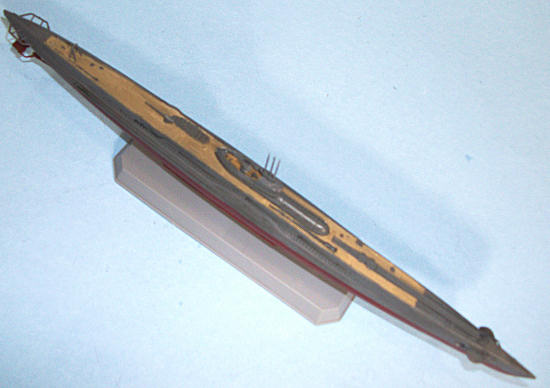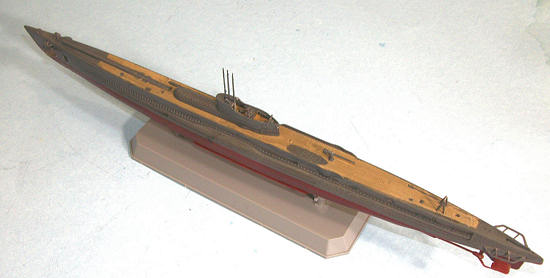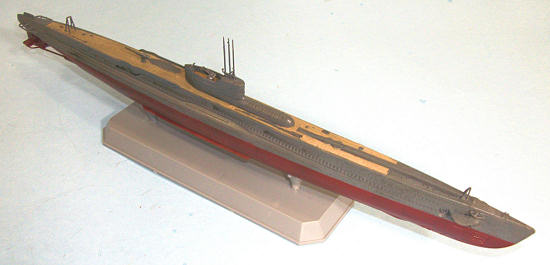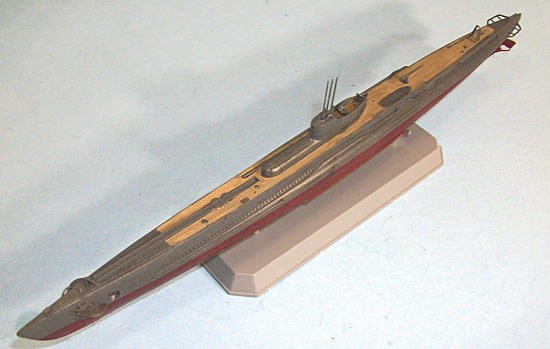Aoshima 1/350 I-27 Submarine

Japan began to develop a submarine force in 1925, based on three types.
The “cruiser” submarines - known to the Japanese as Junsen, and
known generically in the West as “I-boats” - were based on the British “K” Class
and the German U‑139 Class submarines of the First World War. These large
submarines would be used for reconnaissance, operating over trans-oceanic
distances. The Fleet Type, or
Kaidai, was developed from the Junsen, with slightly increased displacement
and intended for co‑operation with
the surface forces and for patrolling enemy shipping routes; these were also
known in the west as “I-boats.” The third class was a short-range medium type
originally derived from the French Schneider‑Laubeuf boats of the First World
War; these were known as “RO-boats.”
The Junsen submarines were designed to operate individually,
replacing cruisers in the reconnaissance role with several equipped with
floatplanes, while the Kaidai were intended to operate in flotillas in
direct co‑operation with the main units of the Japanese Navy. This led to the
boats being designed for maximum performance on the surface, with speed,
sea-keeping, range and gun armament being maximized.
Their high displacement and large size limited submerged maneuverability
and slowed diving time. The effectiveness of American ASW measures would prove
fatal to these large submarines.
At the outset of war, all Japanese submarines were equipped with the Type
95 21 inch, oxygen driven, wakeless torpedo,
 the submarine version of the famous
“Long Lance” torpedo that gave the
United States
Navy such fits in surface engagements in the Solomons.
With a range of 21,880 yds at 50 knots, or 40,000 yds at a speed of 36
knots, the Type 95 was far superior to the 15,316 yds at 28 knots and 6,126 yds
at 45 knots of the American Mark XIV torpedo.
the submarine version of the famous
“Long Lance” torpedo that gave the
United States
Navy such fits in surface engagements in the Solomons.
With a range of 21,880 yds at 50 knots, or 40,000 yds at a speed of 36
knots, the Type 95 was far superior to the 15,316 yds at 28 knots and 6,126 yds
at 45 knots of the American Mark XIV torpedo.
At the time of the
Pearl Harbor
attack, the Imperial Japanese Navy had 64 modern submarines, including 41
cruiser and fleet types. During the Pacific War, Japanese submarines sank 184
Allied merchantmen totaling 907,000 tons. They also sank many warships including
the USS Yorktown, USS Wasp, and the USS
Indianapolis.
129 submarines were lost during the war: 70 sunk by surface ships, 18 by
aircraft, 19 by submarine, and 22 others lost to various other causes. Losses
and new construction balanced out,
with 126 submarines entering service between December, 1941 and August, 1945.
The “B” Class
Cruiser Submarine:
First developed in 1938, the Type B integrated features from both the
Junsen and Kaidai types, with submerged performance slightly
improved: maximum diving depth was being increased to 328 feet.
29 Type B submarines were produced in three successive variants between
1939 and 1944. The superstructure
was more streamlined than in earlier boats to improve submerged performance.
All these submarines could carry a
Yokosuka
E14Y-1 (“Glen”) reconnaissance floatplane in a hangar forward of the conning
tower, with a launching catapult built into the forward casing.
Surface armament was a 25 mm twin mounts on the conning tower for
anti-aircraft defense, and a 5.5 inch 50‑cal deck gun in the rear main deck.
While the Type B was not immune to the serious shortcomings of the large
Japanese submarines, they were effective in their designed
roles, achieving good results against auxiliary and merchant shipping -
56 ships totaling 372,730 tons were sunk, while 14 other ships totaling 91,612
tons were damaged. Type B
submarines sank three American destroyers and one submarine.
The Type B submarine “I-27" was laid down at
Sasebo
Navy Yard as Submarine No. 140 on
July 5, 1939.
She was launched
Jun 6, 1940
and renumbered I-29. On November 1,
the designation was changed definitively to “I-27" and the submarine was
commissioned on
February 24, 1942.
Departing
Kure
on
April 15, 1942,
bound for Truk in company with I‑28 and I‑29, the three submarines were diverted
on April 18 to find and attack the American Task Force 16, which had launched
the Doolittle Raid on
Tokyo.
Failing in this, I-27 and the others arrived at Truk on April 24.
The submarine left Truk for her first war patrol on April 27, arriving
off
Brisbane,
Australia,
on May 3 to support the planned invasion of
Port Moresby.
With the invasion put off after the
Battle
of the
Coral Sea,
I-27 returned
 to Truk on May 17, assigned to Captain Sasaki's Special Attack
Unit that included I-22 and I-24.
Each carried a midget submarine, intended for a strike at
Sydney
harbor.
to Truk on May 17, assigned to Captain Sasaki's Special Attack
Unit that included I-22 and I-24.
Each carried a midget submarine, intended for a strike at
Sydney
harbor.
On
May 24, 1942,
I-29 launched her floatplane to conduct a reconnaissance of
Sydney
harbor, during which the American cruiser USS Chicago was spotted in
port. The attack was made on
May 31, with three midget submarines penetrating the harbor defenses.
HA-14, the midget launched by I-27, entered the harbor by following the
ferry from Manly to
Circular
Bay.
Turning towards the center of the harbor, the midget became
entangled in the boom net between Georges Head and Watson's Bay, fouling
its propellers. The midget was
spotted from the nearby floating crane, and the harbor patrol boat HMAS
Lolita makes two passes, dropping a depth charge on each, both of which
failed to explode in the shallow water.
As the patrol boat circled for a third pass, the Japanese crew detonated
the forward scuttling charge to prevent capture.
Lolita was nearly swamped by the explosions, while debris from the midget
was hurled into the air. The
torpedoes were later salvaged and the crew was given a proper military funeral.
Many Australians objected to this, but the Prime Minister stated he had
ordered such treatment to try and obtain proper treatment of Australian POWs
held after the fall of
Singapore.
Patrolling
Eastern Bass Strait
on June 4, I-27 spotted the 4,239‑ton freighter “Barwon,” en route from
Melbourne
to Port Kembla. A torpedo fired by
I-27 missed, passing under the ship and exploding on her far side, allowing the
ship to escape. That afternoon off
Cape
Howe,
I-27 intercepted the armed ore carrier “Iron Crown,” which was torpedoed
and sunk for the submarine’s first score.
An RAAF
Hudson
of No. 7 Squadron, piloted by F/Lt. C.C. Williams, spotted I-27 right after the
sinking of “Iron Crown” and attacked unsuccessfully with two 250‑lb
anti‑submarine bombs. I‑27 then left
Australia
and returned to
Kwajalein.
Patrolling the
Bay of Bengal
on her third war patrol, one of I‑27's torpedo men developed acute appendicitis.
The medical officer, Surgeon Lt(jg) Nakao Jinichi, performed an emergency
appendectomy at 130 foot depth using the officers' mess table, an event similar
to that which happened on USS Silversides a few months later.
Through late 1942 and all of 1943, I-27 conducted seven more patrols in
the Indian Ocean, the Gulf of Oman, the Arabian Sea and off the east coast of
Africa, sinking 12 Allied ships in the course of these patrols.
On February 5, 1944, the British troop‑carrying convoy KR.8 departed
Kilindini, East Africa, for Colombo, Ceylon with
6,311 Army troops, Royal Navy personnel, medical staff, and members of
the Women's Territorial Service. Escorted by the heavy cruiser HMS Hawkins,
and destroyers HMS Paladin and HMS Petard, the convoy was spotted
by I-27 approaching One and a Half Degree Channel in the
Indian Ocean.
I-27 penetrated the screen, planning to attack the heavy cruiser.
A spread of four torpedoes were fired at the cruiser, which was partially
overlapped by SS “Khedive Ismail,” the lead ship of the center column.
The first torpedo hit “Khedive Ismail” in her starboard engine
room, followed 5 seconds later by the second hit in the forward boiler room,
causing a major internal explosion.
The ship then broke in two and corkscrewed beneath the surface only one minute
and 40 seconds after the first hit. Of 1,511 passengers and crew 1,279 were
lost, including 77 women.
 Following the sinking of Khedive Ismail, multiple periscope sightings
were reported by different vessels.
HMS Paladin obtained a sonar contact north of the now-sunken ship and dropped 10
depth charges to no effect. This
was followed several minutes later by a second unsuccessful attack with 10 depth
charges, but minutes later the sonar operator reported noises resembling the
blowing of ballast tanks and a third attack was made with 9 depth charges.
Following the sinking of Khedive Ismail, multiple periscope sightings
were reported by different vessels.
HMS Paladin obtained a sonar contact north of the now-sunken ship and dropped 10
depth charges to no effect. This
was followed several minutes later by a second unsuccessful attack with 10 depth
charges, but minutes later the sonar operator reported noises resembling the
blowing of ballast tanks and a third attack was made with 9 depth charges.
HMS Petard also made unsuccessful attacks, then made to pick up survivors
of “Khedive Ismail.” As the
destroyed slowed to do this, I-27 suddenly surfaced a mile away from the two
destroyers, down by the stern. Both
ships opened up on the submarine with every gun.
HMS Petard passed close to I-27's stern and fires three depth charges,
which had no effect.
As the submarine attempted
to move off at slow speed, the CO of HMS Paladin decided to ram her.
Ordered not to ram, Paladin turned aside and grazed the submarine,
tearing an 80 foot long gash 12 inches below the destroyer’s waterline, flooding
her engine and gearing rooms, two fuel tanks and the rear magazine.
Paladin went dead in the water and started listing.
Five seamen on I-27 attempted to man the deck gun but were cut down by
fire from the destroyer’s Number 2 AA gun.
HMS Petard launched a total of six torpedoes one by one at I-27,
all of which missed. A seventh
torpedo finally hit I-27 amidships, blowing her in half and sinking her
immediately. There were no
survivors.
Aoshima’s I-27 kit is the first of a series of kits of Japanese I-boats.
This kit provides options to display the submarine with or without the
midget submarine carried during the
Sydney
Harbor
attack. Other kits provide an
E14Y-1 seaplane. The molded parts
are very petite, with excellent scribed surface detail.
As with most submarine models, the parts count is well under 100.
 Construction is straightforward and easy.
I decided to do the submarine as it would have been seen at sea on
patrol, without the railings and without the various loading booms deployed.
I also decided to display the model as I-27 would have looked during her
commerce-raiding war patrols, without the midget submarine.
Construction is straightforward and easy.
I decided to do the submarine as it would have been seen at sea on
patrol, without the railings and without the various loading booms deployed.
I also decided to display the model as I-27 would have looked during her
commerce-raiding war patrols, without the midget submarine.
Most of the parts are extremely small, and I was very glad to have my new
Optivisor (a Christmas present from SWMBO) which made all the delicate assembly
much less difficult than it would have been otherwise.
Once I had the hull assembled, I pained the lower half with Tamiya “Hull
Red,” then painted the main deck with Tamiya “Buff.”
With those masked off, I painted the upper area with Gunze-Sangyo “IJN
Sasebo
Grey”. After unmasking the model
and attaching the conning tower, I painted the entire model with Tamiya “Smoke”
to bring out surface detail. When
that was dry, I gave the model a coat of Xtracrylix Flat Varnish.
Even in 1/350, this is a pretty big model for a World War II submarine,
reflecting the size of the Japanese I-boats.
It looks quite impressive next to my USS Wahoo fleet boat, and the much
smaller German U-boats. Submarine
models are an easy way into ship modeling, and they always look good when
finished.
Review kit
courtesy of HobbyLink
Japan.
Tom Cleaver
January 2011If you would like your product reviewed fairly and quickly, please
contact
me or see other details in the
Note to
Contributors.
Back to the Main Page
Back to the Review
Index Page


 the submarine version of the famous
“Long Lance” torpedo that gave the
the submarine version of the famous
“Long Lance” torpedo that gave the  to Truk on May 17, assigned to Captain Sasaki's Special Attack
Unit that included I-22 and I-24.
Each carried a midget submarine, intended for a strike at
to Truk on May 17, assigned to Captain Sasaki's Special Attack
Unit that included I-22 and I-24.
Each carried a midget submarine, intended for a strike at 
 Construction is straightforward and easy.
I decided to do the submarine as it would have been seen at sea on
patrol, without the railings and without the various loading booms deployed.
I also decided to display the model as I-27 would have looked during her
commerce-raiding war patrols, without the midget submarine.
Construction is straightforward and easy.
I decided to do the submarine as it would have been seen at sea on
patrol, without the railings and without the various loading booms deployed.
I also decided to display the model as I-27 would have looked during her
commerce-raiding war patrols, without the midget submarine.